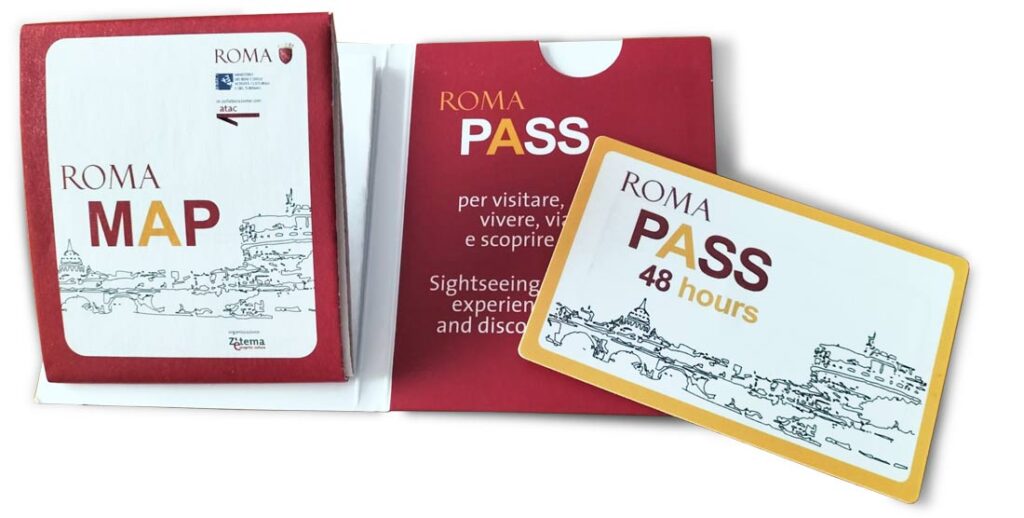Roma Pass and other cards

Here are the main Rome tourist cards you should know about, to see if they might be of interest to you.
1. Roma Pass
The Roma Pass is a popular tourist card promoted by the City of Rome, the Ministry of Culture, and other institutions. It offers discounts on museum and monument admission, free transportation, and some interesting services for the duration of the card’s validity.
Its profitability is quite tight, and it is generally not profitable for those who are entitled to discounts based on age or profession.
It is offered in two modalities: 72 hours and 48 hours.
Roma Pass 72 hours
- It costs 58.50 euros
- It allows free entry to the first two monuments and reduced entry to the rest.
- Free public transport within the municipality (metro, buses, etc.)
- It lasts 72 hours, starting from the activation of the card at the first monument or means of transport.

Roma Pass 48 hours
- It costs 36.50 euros
- It allows free entry to the first monument and reduced entry to the rest.
- Free public transport within the municipality (metro, buses, etc.)
- It lasts 48 hours, starting from the activation of the card at the first monument or means of transport.

In addition, the Roma Pass allows free entry to public restrooms at the city’s newly built infopoints . For those without a Roma Pass, restroom use costs €1.
Here you can see the list of museums and monuments included in the Roma Pass tour.
What does the Roma Pass Kit include ?
The card is offered in a KIT that includes:
- The PASS card. The pass used to enter monuments and use public transportation.
- Map of Rome with the city’s points of interest and monuments included in the discounts.

Where do I buy the Roma Pass ?
Getting a Roma Pass is very easy, thanks to the wide range of sales outlets available. You can buy it:
- In all affiliated Monuments and Museums
- At the Tourist Information Offices at the airports .
- At Termini Station (building F, platform 24)
- At other tourist information points in the city:
- The large tourist information center halfway along Via dei Fori Imperiali
- The small kiosk on Via del Corso (corner of Via Marco Minghetti), near the column of Marcus Aurelius
- The kiosk next to the Castel Sant’Angelo (Piazza Pia).
- At several Metro stations, for example:
- Metro A: Anagnina, Battistini, Lepanto, Ottaviano, Spagna
- Metro B: Laurentina, Eur Fermi, Ponte Mammolo, Termini
- The Roma Pass can also be purchased online , but it doesn’t make much sense. It’s not cheaper, and it’s easier to get it at any of these points of sale.
What means of transport is it valid on?
- On all metro lines
- Municipal buses and trams
- Regional trains Rome-Lido, Rome-Viterbo and Rome-Giardinetti on the municipal route (indicated on all metro maps)
They are not included in the Roma Pass…
Please note that the Roma Pass does NOT include:
- The entrance to the Vatican Museums
- Transportation from the airports to the city
- Travel on regional trains (FL lines)
How do you use it?
The PASS card included in the Kit must be filled out with the name, surname and activation date written on the back.
Regardless of when the Kit was purchased, the PASS card is activated with the visit to the first monument (for all other monuments) and with the first trip (for all other trips).
The card must be shown at the ticket office of the monuments along with an identity document.
On the metro , the ticket machines at the ticket gates have a slot for regular tickets and a screen that reads the Roma Pass barcode . On buses , however, you just need to have the card with you (the ticket validation machine is not designed to read this card).
When does the card expire?
For monuments, it expires 72/48 hours after it is used on the first monument. For transportation, it expires 72/48 hours after it is used on the first means of transportation.
List of monuments included in the Roma Pass
The number of monuments, museums, and other entities affiliated with the Roma Pass is growing over time. Currently, the sites that have signed up with the Roma Pass are divided into three categories:
1. Public museums and monuments (state and municipal).
2. Privately managed venues and events
3. Tourist services
1. MUSEUMS AND PUBLIC MONUMENTS
Here is a table with the most important ones, ordered by relevance, according to our criteria:
Main monuments:
- Colosseum, Roman Forum and Imperial Forums
- Baths of Caracalla
- Trajan’s Markets and the Imperial Forum Museum
- Castillo de Sant’Angelo
- Altar of Peace
- Mausoleum of Augustus
- Monuments of the Via Appia
- Valentini Palace (Plaza Venecia)
- Excavations of the Circus Maximus
- Ostia Antica (very interesting, although quite far away)
Main museums:
- Capitoline Museums
- Borghese Gallery
- National Roman Museum – Palazzo Massimo
- Barberini Palace (National Gallery of Ancient Art)
- National Roman Museum – Palazzo Altemps
- National Roman Museum – Crypta Balbi
- National Roman Museum – Baths of Diocletian
- Etruscan Museum (Villa Giulia)
- MAXXI National Museum of 21st Century Arts
- Spada Gallery
- Palazzo Venezia (National Museum)
- National Museum of Musical Instruments
- Civic Museum of Zoology (natural museum, in Villa Borghese)
- Palacio Corsini (National Gallery of Ancient Art)
Other museums that are also of interest (but are free for everyone):
- Napoleonic Museums
- Museum of the Walls
- Barracco Museum (of Ancient Sculpture)
- Pietro Canonica Museum (Villa Borghese)
- And other free monuments
You can see the complete list of museums and monuments on the official website .
2. PRIVATELY MANAGED VENUES AND EVENTS
The second section includes places or activities not managed by public entities, where the Roma Pass entitles you not to free entry, but to certain discounts. It includes a wide variety of places, such as:
Monuments and archaeological areas:
- Villa Medici
- Goethe’s House
- City of Water (área arqueológica junto a la Fontana de Trevi)
- Ruins of the Stadium of Domitian (Piazza Navona)
- Underground of San Nicola in Carcere
Museums and interesting places:
- Hebrew Museum (next to the Synagogue)
- Cinecittà, the famous film studios
- Two museums about Leonardo da Vinci
- Bioparco, a small zoo in Villa Borghese
- The Planetarium
- The Wax Museum
- Gladiator Museum (shop in Piazza Navona)
- Gladiator Show (Via Appia)
Multimedia shows:
- Augustus: Welcome to Rome
- Circus Maximus Experience
- Ancient and Recent
Auditoriums and exhibition spaces:
- Music auditoriums
- Ballet
- Theaters
You can see the complete list of these places on the official website .
3. TOURIST SERVICES
This third category includes services offered by various tour operators:
- Electric bike tours, segways, motorcycles…
- Bike and motorcycle rentals…
- Tourist buses
- Lockers for storing luggage
- Health services
You can see the full list on the official website , where you’ll see the discounts that apply in each case.
Is the Roma Pass cost-effective ? How much do you save?
The Roma Pass’s profitability has fluctuated significantly in recent years, but it’s generally very tight. If you want to get the most out of it, keep the following in mind:
- Download the updated list of rates and discounts to make your calculations.
- Use the Roma Pass to enter the most expensive monument first.
- Then, take advantage of the opportunity to enter those monuments with the biggest discounts. For example, at Palazzo Barberini, the regular ticket costs €12 and the reduced ticket costs €2 (saving €10), while at the Capitoline Museums, you save just €3.50 between the regular and reduced ticket prices.
IMPORTANT: Those entitled to reduced entry will almost certainly lose money, as the Roma Pass does not offer age-based discounts. Children and those entitled to free entry to monuments should not purchase the Roma Pass under any circumstances.
USEFUL LINKS
On the official Roma Pass website you will find a wealth of information:
- Home: www.romapass.it
- Rome map in PDF format, with all the city’s highlights included in the Roma Pass discounts.
- List of current rates for public monuments: www.romapass.it – biglietti
2. Other cards

The famous Roma Archaeologia Card , which gave access to various monuments of ancient Rome for 7 days, no longer exists .
Instead, some combined tickets have been left:
- Colosseum + Roman Forum and Palatine Hill . There are several types of admission tickets, which you can see on our Roman Forum page: Colosseum and Forum Tickets .
- Museo Nazionale Romano (MNR) . Tickets cost €10 for just one site, and €12 for a combined ticket, valid for 7 days, which allows entry to all four sites: Palazzo Massimo alle Terme, Palazzo Altemps, Crypta Balbi, and the Baths of Ciocletian. For more information, visit our Rome rates page .
- Monuments along the Appian Way . This ticket no longer includes the Baths of Caracalla, but also includes: the Mausoleum of Cecilia Metella, the magnificent Villa dei Quintili, the excavations at Capo di Bove, the Museum of Lucrezia Romana (somewhat further away), the tombs along the Via Latina, and the Villa di Sette Bassi (the latter two by reservation). Valid for 3 days. More information can be found in our special section on Appian Way timetables and fares .

There is also a card (of little interest to tourists) called La Mia Appia card , which grants unlimited access to the monuments along the Appian Way for a year. For more information, visit parcoarcheologicoappiaantica.it.

